
Best Camping & Backpacking Coffee Makers of 2025
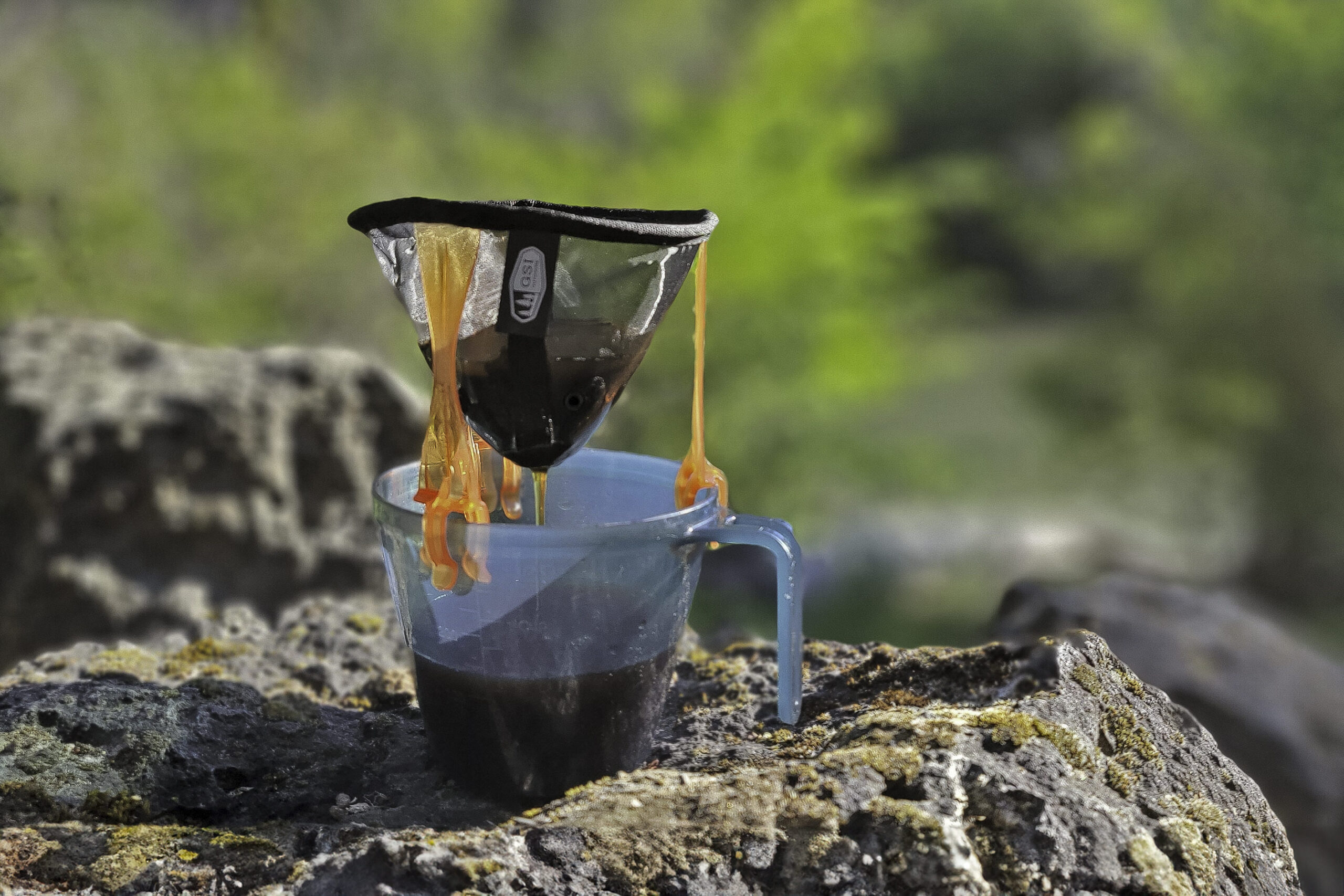
For many backpackers, there’s one piece of camp kitchenware they wouldn’t dream of leaving home without: a coffee maker. After all, there’s nothing quite like a piping hot cup of caffeine to entice you out of your sleeping bag on chilly mornings.
But just because you’re camping or backpacking, away from all the tools and comforts of your home kitchen, doesn’t mean you have to settle for a subpar brew. On the contrary, there are plenty of options available that can brew a quality mug in no time, even in the backcountry. We tested 10 to see how they stacked up, what kind of coffee they make, and what you might want to pack on your next excursion.
And for more info, check out some of our other popular gear guides:
Quick Picks for Camping Coffee Makers
Check out this quick list of our top choices, or keep reading to see our full list with in-depth reviews.
Best coffee maker overall: AeroPress Go Travel ($50)
Best one-pot coffee maker: Bialetti Moka Express
Best ultralight coffee maker: GSI Outdoors Ultralight Java Drip ($11)
Most compact coffee makter: MiiR Pourigami ($30)
Most convenient coffee: KUJU Coffee Pocket Pourover ($15)
Fanciest coffee maker: GSI Outdoors Mini Espresso ($40)
Best camp espresso: Wacaco Minipresso ($55)
Best coffee to-go: ESPRO Ultralight Travel Press ($40)
Best for Jetboil users: Jetboil Silicone Coffee Press ($19)
Best for groups: GSI Outdoors Java Press ($40)
What’s new
We updated this list this year to showcase our new favorite coffee-making devices for camping and backpacking. A few items were removed, but we’re more excited about what’s new on the list, including a few stovetop espresso makers.
- The Bialetti Moka Pot has long been a favorite for home brewing, but its durability and ease of use, along with its ability to make a strong cup of coffee, have earned it a place of honor this year.
- Similarly, the GSI Outdoors Mini Espresso Set follows a comparable concept, but it’s designed for solo campers and includes an insulated demitasse.
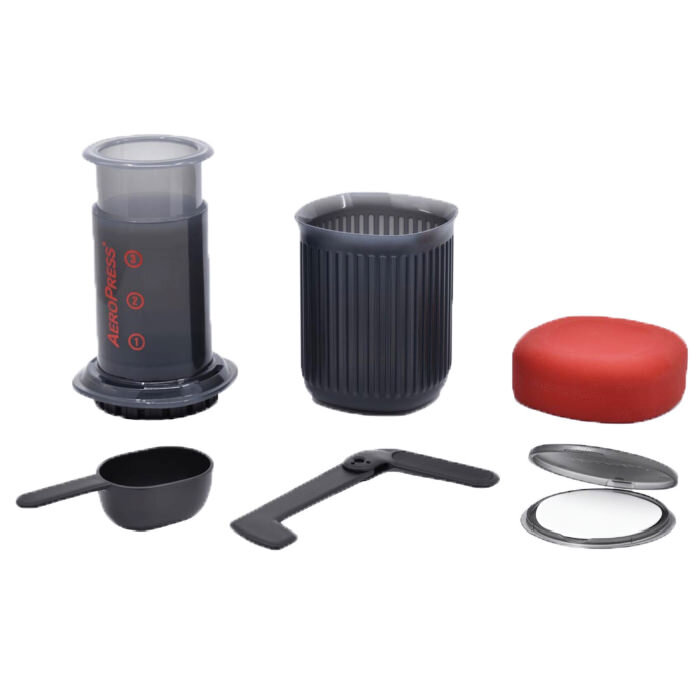
AeroPress Go Travel Coffee Press
Best coffee maker overall
CleverHiker Rating:
5.0/5.0
Price:
$50
Liquid Capacity:
8 oz.
Weight:
11.5 oz.
Size:
5.3 x 3.9 x 3.9 inches
Pros
- Can customize coffee strength
- Comes in a convenient package
- Can be made zero-waste
- Easy to clean
- Fast coffee prep
- Durable construction
- Makes different types of coffee
Cons
- Mug isn’t insulated
- Only makes 1-2 small cups at once
Since we first got our hands on the inimitable Aeropress Go, we were smitten. After all, what other coffee-making device can produce espresso, French press-style coffee, or even cold brew in such a compact package? What’s more, this simple brewer excels at making the precise strength of brew you desire. Just adjust your technique using one of many different brewing styles to take your cup from light to dark with just a few tweaks.
That’s because, in addition to using the Aeropress as a cross between a pour-over and a French press, you can invert it, add coffee and water, let it steep for several minutes, and then press it for a stronger espresso-style cup. That was our favorite method during testing. You can also increase the ratio of coffee to water or adjust the grind size and taste the difference. The options are endless, and a quick search on YouTube will reveal as many brewing methods as there are coffee drinkers.
It comes in a durable, convenient, all-in-one travel-ready package that includes a coffee scoop, stir wand, filters–which can be replaced by a reusable metal filter to reduce waste–filter keeper, mug, and lid. Everything nests together for easy storage and transport, and despite years of being knocked around, dropped, and tossed into storage bins on numerous camping trips, ours remains as robust and functional as ever.
It may not be the cheapest coffee maker on this list, but due to its versatility and capacity to brew multiple styles and strengths of coffee, we believe it’s a worthwhile investment. Additionally, for those who prefer a more user-friendly insulated mug, there’s also the new Aeropress Go Plus, which offers the same great functionality with an improved vessel.
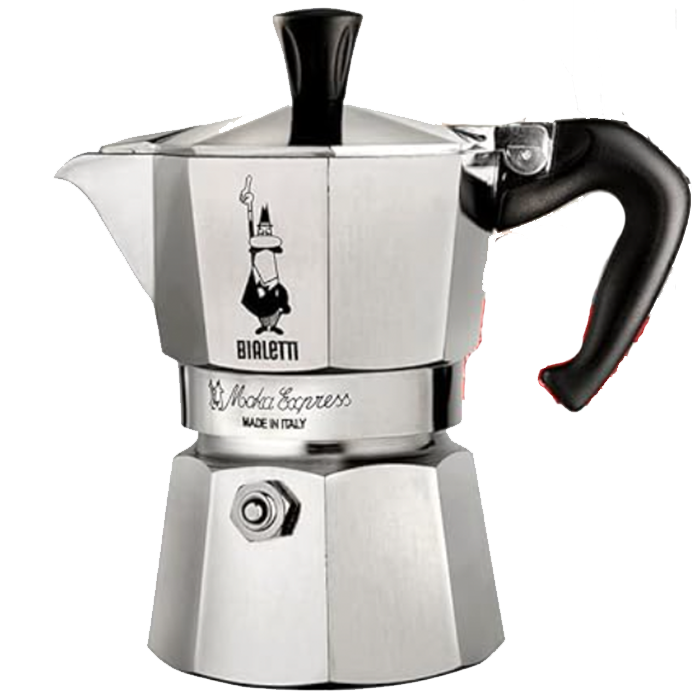
Bialetti Moka Express
Best one-pot coffee maker
CleverHiker Rating:
4.8/5.0
Price:
$40
Liquid Capacity:
4.3 oz.
Weight:
7.4 oz.
Size:
4 x 5.6 x 6.7 inches
Pros
- No kettle required
- Makes strong coffee
- Durable
- Inactive brew time
- Easy to use
- Reliable results
Cons
- Not quick to clean
- Takes time to cool
- Only makes 1-2 small cups
We’ve been using a Bialetti Moka Pot around the house for years, and it makes sense that this easy-to-use, one-pot wonder would be just as suitable for outdoor adventures. It has a cult following for a reason, and not just in Italy, where this hardy metal brewer originated; outdoor enthusiasts around the world appreciate it for its ease of use, reliability, and straightforward functionality.
It also makes strong coffee. That’s thanks to a design that works like a classic percolator but with more pressure and a finer grind, ensuring every bit of flavor is extracted as water bubbles up through the grounds into the upper reservoir. The result is a piping hot cup of espresso-strength brew in just a few short inactive minutes. This means there’s no need for pre-boiling water or careful pouring: just fill the base with cold water, the basket with grounds, screw on the top, set it on your camp stove, and let it do its thing.
The Moka Express is durable due to its nearly all-metal construction; only the handle and lid knob are made of heat-resistant plastic. So, there’s no need to worry if it falls off a picnic table or rolls across your campsite; it can take it. We’ve dropped ours plenty of times over the years while using it indoors and outdoors. The only part that will need to be replaced regularly is the rubber seal inside the top.
It’s heavy for backpacking if you keep your kit ultralight, but if you don’t mind carrying a few extra ounces for a quick, easy, strong cup of coffee, we have few complaints. Just bring a towel so you can disassemble it for cleaning or reloading if you don’t want to wait for it to cool.
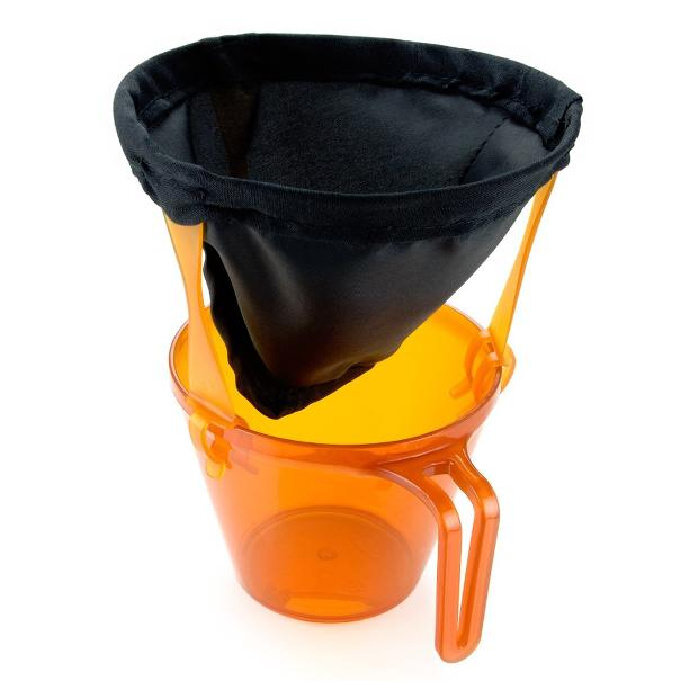
GSI Outdoors Ultralight Java Drip
Best ultralight coffee maker
CleverHiker Rating:
4.7/5.0
Price:
$11
Liquid Capacity:
1 cup
Weight:
.4 oz.
Size:
4.2 x 4.2 inches
Pros
- Customizable flavor profile
- Simple to use
- Ultralight
- Inactive brew time
- Inexpensive
- Packs flat
- No filter required
Cons
- Damp after use
- Makes one cup at a time
The GSI Ultralight Java Drip is truly a backpacker’s dream: it packs flat, weighs almost nothing, and allows you to customize coffee strength by adjusting the size of the grinds you use for your classic pour-over coffee. It’s easy to clean up when you’re done, and although it only makes one cup at a time, it’s simple to reset for the next brew.
It’s designed with a reusable and washable mesh fabric basket instead of the typical hard-sided cone found on most pour-over devices. This means you don’t need to pack extra filters; just add grounds to the basket and pour hot water on top. Three plastic legs feature clips at the end that fit onto the rim of most travel and camp mugs, as well as mugs in your cabinet at home.
For a stronger brew, we found during testing that we preferred a slightly finer grind due to the faster flow-through rate compared to most paper filters, but you can easily customize your brew strength by using a finer or coarser grind. After brewing, cleanup involved dumping out the grounds and rinsing the filter, making it quick and easy. However, this also meant that when backpacking in Utah, we had to pack away the device while it was still wet. It’s not a deal-breaker, but it’s not ideal, either.
It is extremely lightweight, so even ultralighters can consider making the switch from instant. And although it may not be the most durable option we tested, it’s hard to argue with the value at such an affordable price point.
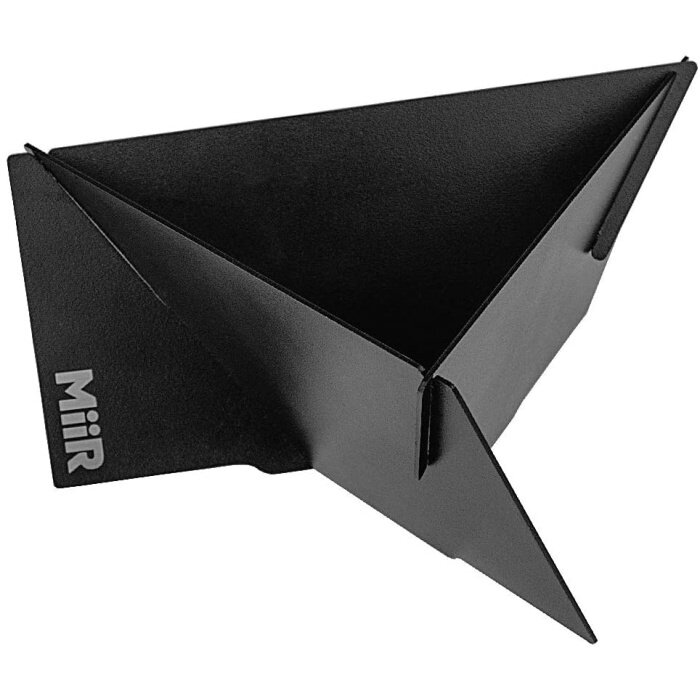
MiiR Pourigami
Most compact coffee maker
CleverHiker Rating:
4.7/5.0
Price:
$30
Liquid Capacity:
1 cup
Weight:
3 oz.
Size:
5.5 x 2.75 x 0.75 inches
Pros
- Folds flat
- Highly portable
- Comes with carry case
- Customizable coffee strength
- Can use reusable filters
- Durable
Cons
- Heavy for backpacking
- Specific filters recommended
If you’re looking for the most compact and portable pour-over cone available, the MiiR Pourigami is it. While it may not weigh as little as some other pour-over devices, it occupies less space. It collapses almost completely flat and reassembles using slides and notches on three identical pieces that come together to form a triangular cone. Simply place a filter with coffee grounds inside, add water, and you have your cup of coffee. It even includes a folding storage sleeve with space for filters.
Using specific cone-shaped filters is recommended. During testing, we found that traditional #4 filters could be used, but they didn’t fit as well and were more prone to breaking along the bottom seam. Fortunately, reusable filters were also effective and helped reduce waste.
It is made entirely of stainless steel, making it durable, and the grooves in the base help it stay centered on almost any size camp mug. The steel also means it is heavy, so not all backpackers may prefer it. However, cleanup is easy: simply dispose of the filter and grounds, then wipe or rinse the device before disconnecting the interlocking panels and storing them in the sleeve.
This is the coffee maker we intend to keep in our camp kitchen box at all times because it takes up almost no space, leaving more room for essential items like additional coffee.
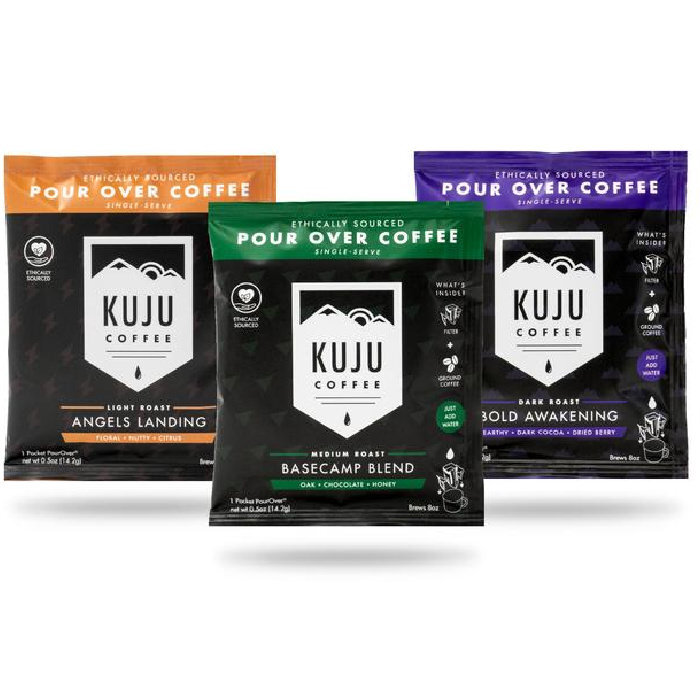
KUJU Coffee Pocket Pourover
Least preparation and cleanup
CleverHiker Rating:
4.7/5.0
Price:
$15
Liquid Capacity:
1 cup
Weight:
3 oz.
Size:
3.88 x 4.75 inches
Pros
- Ultralight
- Easy to use
- Instant cleanup
- Available in multiple roasts
- No grinding required
Cons
- Single use
- Can’t customize coffee strength
Campers and backpackers who don’t want to deal with coffee makers but also prefer something better than a typical packet of instant coffee should consider the Kuju Coffee Single-Serve Pour-Over. It’s small, lightweight, and provides an easy way to brew coffee–and clean up afterward–when you’re away from your kitchen.
All that’s needed is hot water, a mug, and a packet of Kuju. Each packet contains a single serving, so open one, extend the paper arms, tear open the top of the coffee pouch, and hang it on the rim of your camp mug. Add hot water, pour-over style, and in about three minutes, you’ll have a cup with minimal prep required. To clean up, simply toss the whole pouch in the trash. It is a single-serve device, which makes it easy to use but results in more waste.
We tried the Base Camp medium roast, which offered a smooth flavor and medium-strength brew. Since it comes pre-packaged, you can’t adjust the strength of your coffee, so what you buy is what you get. However, there are multiple flavor profiles available, ranging from light to dark roasts, so you’re likely to find one you enjoy.
Since the individual packages are small, they are portable and ultralight, making them perfect for backpackers whose coffee standards exceed those of typical instant.
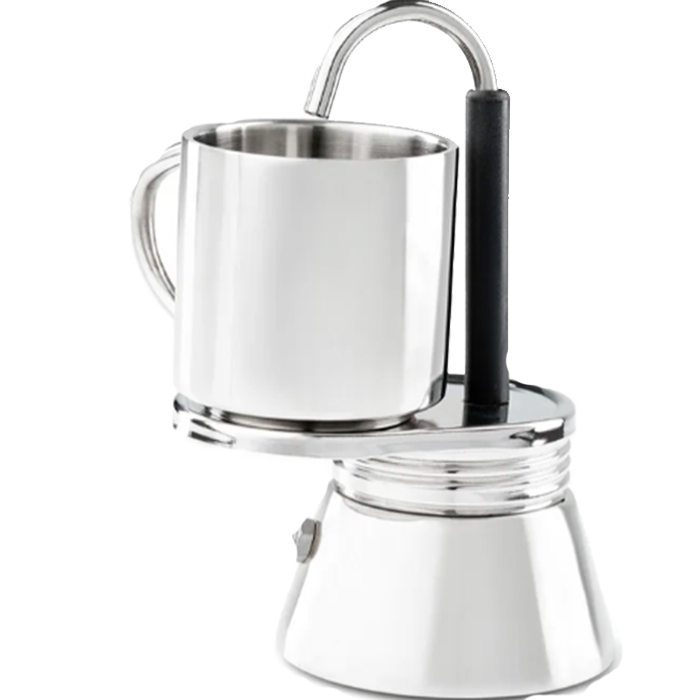
GSI Outdoors Mini Espresso Set
Fanciest coffee maker
CleverHiker Rating:
4.6/5.0
Price:
$40
Liquid Capacity:
2.5 oz
Weight:
11 oz.
Size:
5.9 x 3.6 x 3 inches
Pros
- All-in-one system
- Makes espresso-strength coffee
- Can be used to make an Americano
- Comes with protective case
- Inactive brew time
- Durable
Cons
- Makes one cup at a time
- Cooldown required before cleanup
- Small base
When we want to impress our friends and family with our coffee skills on camping trips, we pull out the GSI Mini Espresso Set. Similar in concept to the Bialetti Moka Express, it uses heat to generate pressure and brew a strong cup of espresso right into a waiting cup. It’s easy to use: just add water to the base and coffee grounds to the basket, then place it on top of a hot stove and wait. In a couple of minutes, a hot shot of coffee will be ready to drink in the included insulated cup.
The entire set comes in a sturdy, protective case for easy transportation. It also kept the espresso maker in pristine condition, even when we carelessly tossed it into a camp kitchen box in the back of the car during road trips and campouts in Utah and Idaho.
We appreciated that we didn’t have to pre-boil water in a pot or kettle to brew, but this does mean the entire device gets hot, making it difficult to clean or reset for another cup before the espresso maker cools down. However, we could still manage to do both as long as we had a small camp towel to protect our hands from the heat.
It produces one shot at a time, but that shot can be diluted with hot water to create an Americano. There is also a 4-cup version of the device available if you want a few more fluid ounces of coffee. Additionally, the base is small, so it may not fit on all stoves, but we found that we could make it work with strategic placement in most cases.
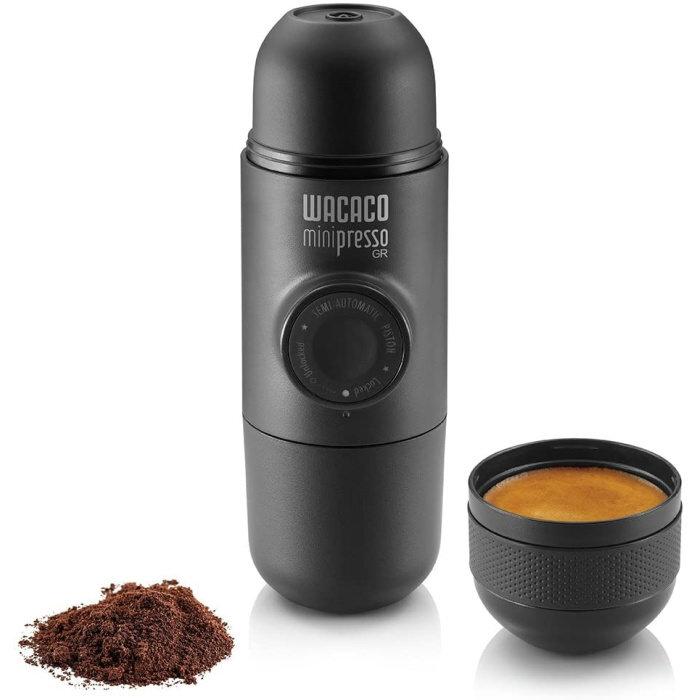
Wacaco Minipresso GR
Best camp espresso
CleverHiker Rating:
4.5/5.0
Price:
$55
Liquid Capacity:
2 oz
Weight:
12.7 oz.
Size:
2.76 x 2.36 x 6.89 inches
Pros
- Makes strong espresso
- Makes cold or hot coffee
- Quick preparation
- Two coffee basket size options
- Can be lengthened with water
Cons
- Lots of parts and pieces
- Takes longer to cleanup
- Not as durable
If you’re after cafe-level espresso, there’s no better way to make it in the frontcountry or backcountry than with the Wacaco Minipresso. Not only does it produce a strong shot quickly, but no other espresso maker we tested yielded a cup with crema, a barista must-have. You do have to put in a bit of effort: just under one minute of pumping is needed to build pressure and make one cup. Nevertheless, it still made one of the fastest cups of the bunch.
It prepares hot coffee as well as cold espresso for times when we don’t want to take the time to boil water, like during long road trips or quick pit stops between trailheads. Even though there are many parts to this small machine, it was easy to use once we got the hang of it. We found we had to be careful not to tamp the grounds in the basket too hard, but otherwise, we had no issues with extraction. Plus, there are two basket size options: 8 and 12 grams, allowing you to customize the strength of your espresso.
The device is slightly less durable than other coffee makers we tested, but it still withstands being tossed into a backpack and camp kitchen box without issue. It also includes a storage and transport stuff sack. If you want to make multiple shots, you will need to disassemble and reset the machine; however, cleanup time is minimal despite all the pieces.
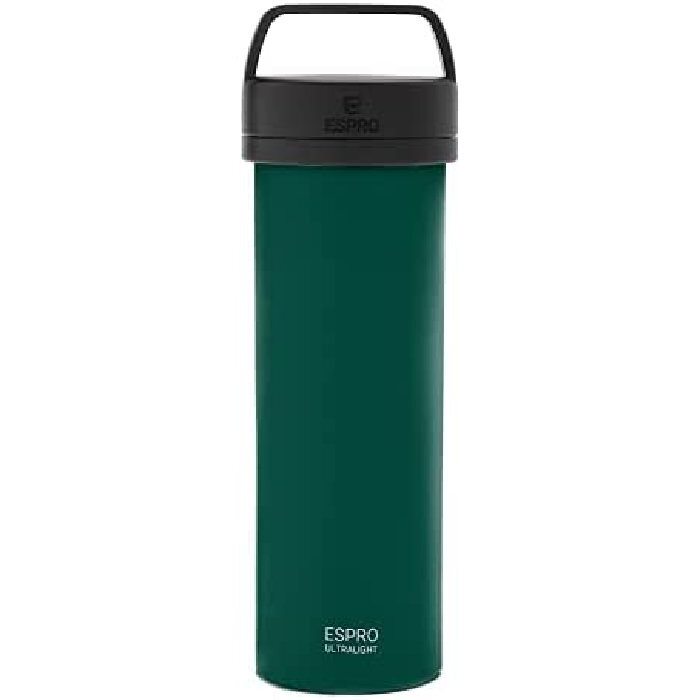
ESPRO Ultralight Travel Press
Best coffee to-go
CleverHiker Rating:
4.3/5.0
Price:
$40
Liquid Capacity:
16 oz
Weight:
7.4 oz.
Size:
2.6 x 3 x 9.2 inches
Pros
- Makes coffee on the go
- Keeps coffee hot
- Also makes tea
- Can customize coffee strength
- Minimal grit
- Durable
- Easy to use
Cons
- Designed for a single user
- Expensive
Sometimes we crave a good cup of coffee without having to wait around to hit the trail. Or we wouldn’t mind having a second cup ready to enjoy for a mid-afternoon pick-me-up later in the day. In either case, the ESPRO Ultralight Travel Press is the perfect coffee-making tool. It’s lightweight, easy to use, brews good coffee, and since the entire device is designed for making coffee on the go, it’s ready to pack up whenever you are.
We love it for early morning trail dates when we prefer to hit snooze one more time rather than wait for coffee to brew. All we had to do was wake up, boil water, add grounds, and let the coffee steep while we got moving. You do have to leave the lid off the mug while the coffee steeps, but as soon as three to four minutes are up, you can press, screw on the lid, and enjoy a leak-proof cup of coffee whenever you’re ready. The double-filter basket even means the last few swigs are nearly grit-free, so we can make a stronger cup using a finer grind than with other French press-style makers.
During testing, the double-walled mug kept our coffee hot for hours, even on chilly days, allowing us to enjoy a warm beverage well into the afternoon after we prepared it in the morning. The pressed-down plunger didn’t interfere with drinking, and the multiple holes in the top let you sip from anywhere around the rim.
The device not only makes coffee but also tea. Just remove the filter’s outer basket, add loose leaf tea and hot water, then press when steeping is done.
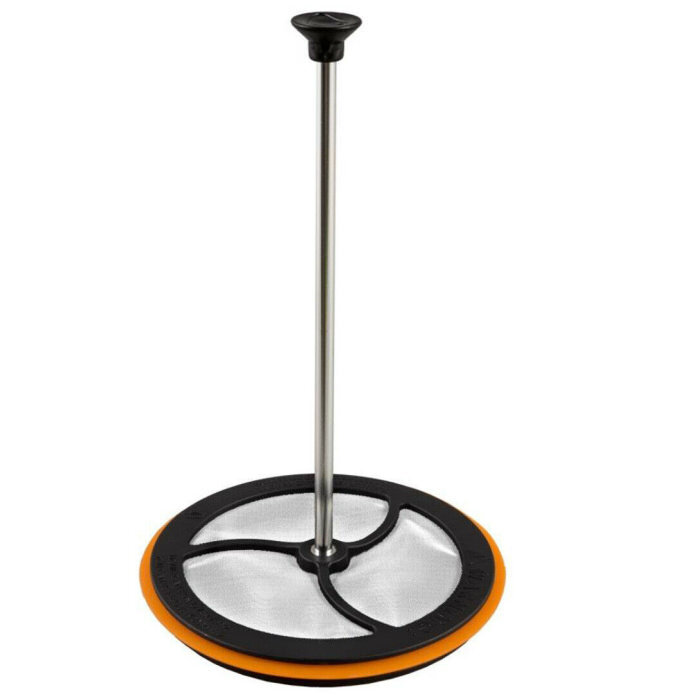
Jetboil Silicone Coffee Press
Best for Jetboil users
CleverHiker Rating:
4.3/5.0
Price:
$19
Liquid Capacity:
33.8 oz
Weight:
1.3 oz.
Size:
3.7 x 5.8 inches
Pros
- Ultralight
- Easy to use
- Easily packable
- Makes several cups at a time
- Can customize brew strength
- Zero waste
Cons
- Can only be used with Jetboil systems
- Must disassemble to pack
If you have a Jetboil cooking system for camping or backpacking, there’s no reason to bring an extra coffee maker when you have the Jetboil Silicone Coffee Press. With this lightweight, portable add-on, you can brew French press coffee using the tools you already have.
It consists of a filter attached to a metal rod that goes through your Jetboil lid and fits perfectly in the pot. To make coffee, boil water in the vessel, add grounds, let them steep for four minutes, then press and serve. It yields between one and three servings of coffee.
The only downside to this system is that you cannot make coffee and boil water for breakfast simultaneously; you will have to decide which comes first. However, this means you do not need to pack extra gear just for making coffee.
It prepares average-strength coffee that can be minimally customized, but we found that using too fine a grind resulted in excess grit at the bottom of our cups. It’s also important to note: You can only use a Jetboil system with IsoPro fuel, and it can’t be employed on a typical camp stove, so this device is best suited for backpacking, not camping where you may utilize a propane-powered camp stove with full-size burners.
While it may be ultralight, you will need to disassemble the device to save the most space. If you leave it in place, you’ll lose the ability to stack items like fuel and your camp stove inside your Jetboil. To optimize the vessel’s interior space, unscrew the two parts of the metal shaft and store them in the plastic cap on the bottom. Then, stash the filter inside the Jetboil. The good news is that it disassembles and reassembles in seconds.
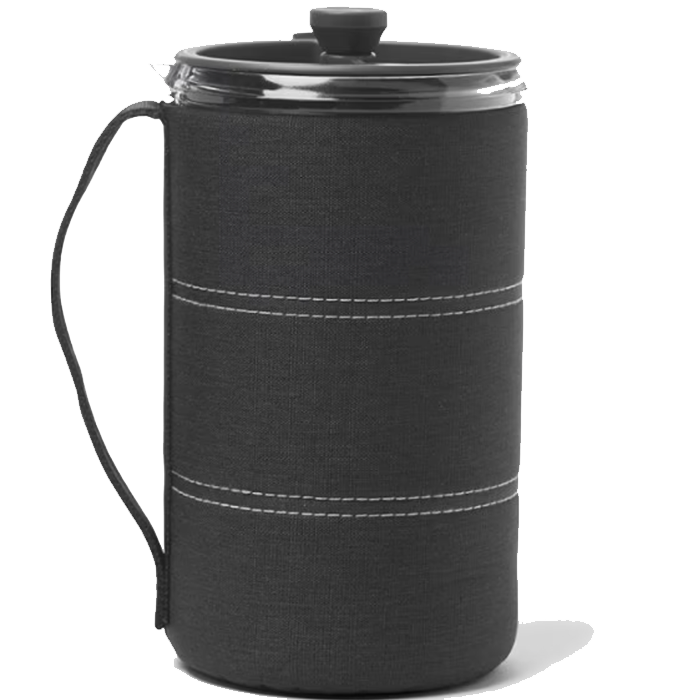
GSI Outdoors Java Press
Best for groups
CleverHiker Rating:
4.2/5.0
Price:
$40
Liquid Capacity:
30 oz
Weight:
10.3 oz.
Size:
7.7 x 4.5 x 4.2 inches
Pros
- Makes multiple cups at a time
- Non-active brew time
- Lightweight per cups brewed
- Can customize strength
Cons
- Can be difficult to clean
- Not easily packable
When you need to make coffee for multiple people, making one large batch instead of one cup at a time is often more time-efficient. For that, the GSI Outdoors Java Press is just the thing. This adventure-ready French press brews two to three cups at a time with no waiting in between. All you need to do is add coffee and hot water to the pitcher, set a timer, then press and pour. It’s an easy way to make more coffee in less time.
You can customize the strength of your brew based on steeping time, but only to a small extent. That’s because when we attempted to make it stronger by using a finer grind during backyard hangouts, we ended up with grit settling at the bottom of each cup. However, as long as we used a medium to medium-coarse grind, grit was minimized thanks to the fine metal mesh filter. Overall, we found that the press generally produced a medium-strength cup on average.
The Java Press is durable, thanks to a Lexan vessel paired with an insulating sleeve. This design meant we were never afraid it would break or scratch. During testing in cold weather, the sleeve didn’t keep the coffee hot for very long, so we transferred the liquid to insulated mugs as soon as it finished steeping. The handle made pouring feel more secure, but we still had to grasp the vessel by the body, not the handle, when it was full.
Packing it isn’t the easiest task. It’s large, and due to the plunger and filter, you can’t easily store items inside the vessel to save space. However, it can be clipped to the outside of a pack using the soft handle. Overall, it brews good coffee and plenty at a time.
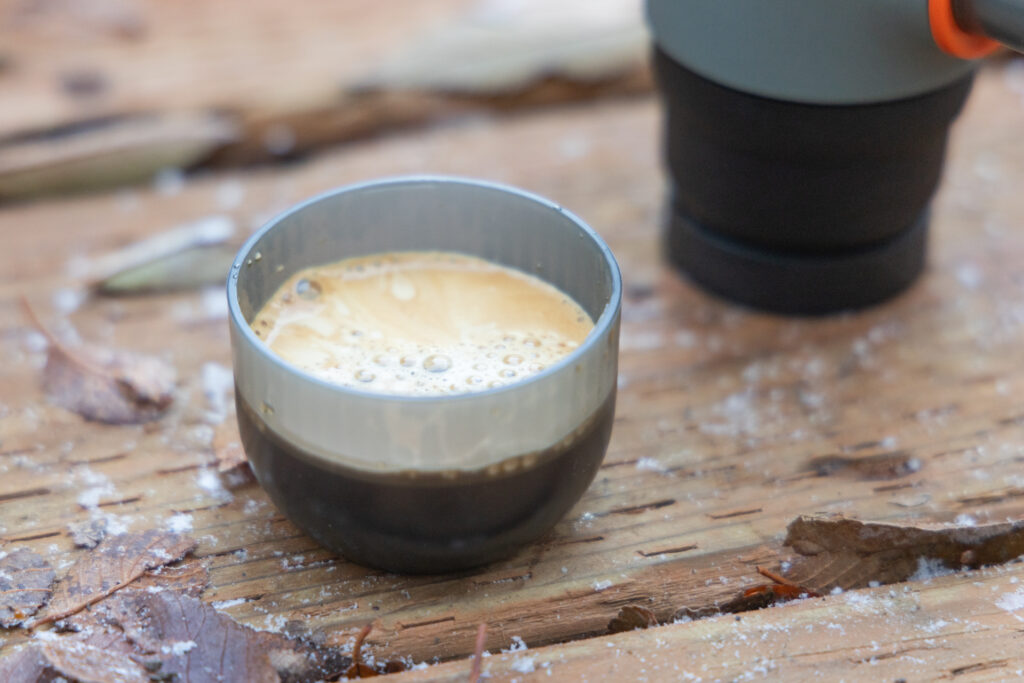
Product Comparison Table
| oSort | Product | Price | Liquid Capacity | Weight | Size | Portability | Ease of Use | Time to Brew | Ease of Cleaning | Strength of Flavor | 0 |
AeroPress Go Travel Coffee Press View at REI View at Amazon |
$50 | 8 oz. | 11.5 oz. | 5.3 x 3.9 x 3.9 inches | 4.5 | 4.1 | 4.5 | 4.8 | 4.4 | 1 |
Bialetti Moka Express View at Amazon |
$40 | 4.3 oz. | 7.4 oz. | 4 x 5.6 x 6.7 inches | 3.8 | 4.8 | 4.7 | 4.1 | 5.0 | 2 |
GSI Outdoors Ultralight Java Drip View at REI View at Amazon |
$11 | 1 cup | .4 oz. | 4.2 x 4.2 inches | 5.0 | 4.9 | 4.3 | 4.5 | 3.9 | 3 |
MiiR Pourigami View at Amazon |
$30 | 1 cup | 3 oz. | 5.5 x 2.75 x 0.75 inches | 5.0 | 4.6 | 3.9 | 4.9 | 4.3 | 4 |
KUJU Coffee Pocket Pourover View at REI View at Amazon |
$15 | 1 cup | 3 oz. | 3.88 x 4.75 inches | 5.0 | 5.0 | 4.1 | 5.0 | 4.1 | 5 |
GSI Outdoors Mini Espresso Set View at GSI Outdoors |
$40 | 2.5 oz | 11 oz. | 5.9 x 3.6 x 3 inches | 3.6 | 4.7 | 4.6 | 4.1 | 5.0 | 6 |
Wacaco Minipresso GR View at Amazon |
$55 | 2 oz | 12.7 oz. | 2.76 x 2.36 x 6.89 inches | 4.4 | 3.8 | 5.0 | 3.8 | 5.0 | 7 |
ESPRO Ultralight Travel Press View at Amazon |
$40 | 16 oz | 7.4 oz. | 2.6 x 3 x 9.2 inches | 4.7 | 4.9 | 3.9 | 3.5 | 4.2 | 8 |
Jetboil Silicone Coffee Press View at REI View at Amazon |
$19 | 33.8 oz | 1.3 oz. | 3.7 x 5.8 inches | 4.9 | 4.8 | 4.2 | 4.1 | 3.8 | 9 |
GSI Outdoors Java Press View at REI View at Amazon |
$40 | 30 oz | 10.3 oz. | 7.7 x 4.5 x 4.2 inches | 3.0 | 4.7 | 3.9 | 4.0 | 3.8 |
|---|
var resetClicked = false;
// When the Reset Table button is clicked, use sortable to reset to the oSort column.
document.querySelector(‘#resetSort’).addEventListener(‘click’, function() {
// If reset has been clicked, do nothing
if (resetClicked) {
return;
}
// Get the defaultSort element and click it to reset sort to the original load order.
const el = document.getElementById(‘defaultSort’)
if (el) {
el.click();
resetClicked = true;
}
});
// Add event listener to all sortable headers to reset the resetClicked flag
var headers = document.querySelectorAll(‘.sortable th’);
headers.forEach(function(header) {
header.addEventListener(‘click’, function() {
resetClicked = false;
});
});
How We Test
We take testing coffee makers as seriously as we do making coffee. We evaluated each one carefully based on several criteria, including the weight of each device and its portability, ease of use, ease of cleaning afterward, and the strength of the coffee it brews. Over several weeks, we brewed dozens of cups outdoors to help you determine which one is right for you.
PORTABILITY
To evaluate each device based on portability, we considered weight and size. When camping or backpacking, space is limited in vehicles, backpacks, and campers, so devices that are compact, durable, or come with travel cases ranked higher. Lightweight devices also scored well since weight is a crucial factor for backpackers. Finally, portability encompassed how easy the coffee maker was to transport, including whether it could be conveniently stowed in a backpack, clipped to the outside, and, if large, whether we could store items like fuel or coffee inside.
EASE OF USE
Ease of use, or how simple it is to make coffee with the maker, was also an important ranking factor, although perhaps less significant for some users. Coffee and the process of making it are very personal, so while some individuals might prefer a quick and easy cup, others may not mind taking a few extra steps to craft their desired beverage.
We ranked these devices based on the number of required parts and pieces that make up the device and the number of steps necessary to prepare coffee. For instance, if we had to boil water separately, if assembly was required, and how many parts and pieces are included with each device. The amount of effort required also played a role; for example, if hands-on pouring or pumping was needed or if you could set it and forget it.
TIME TO BREW
We don’t always feel that we have the luxury of time when preparing coffee at the campground or in the backcountry, so we tested and ranked all these devices based on how quickly they made a cup. We timed how long it took to brew from the moment we combined coffee and water to when we filled our cup. We didn’t include boiling water since boil time varies depending on your stove, kettle, or pot.
We started the clock when we added coffee to the device. For example, when using a pour-over, we timed the addition of coffee to the cone and how long the pour-over process took. With a French press, we timed the addition of water and coffee and how long it took to press, etc.
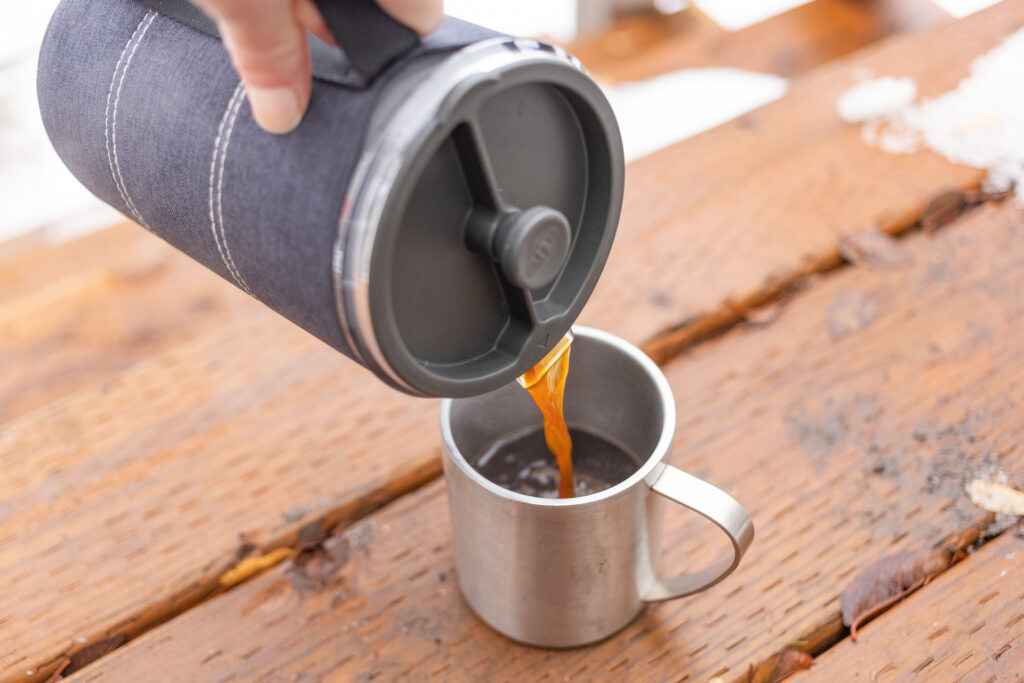
EASE OF CLEAN UP
Since most people don’t have access to a full kitchen while camping and backpacking, cleanup is crucial when making coffee. You must consider not only what to do with your used coffee grounds but also how you will clean the coffee maker once you’re done. Therefore, we used each device and timed how long it took to empty the grounds and rinse out the coffee maker until no grounds remained.
We also considered whether a cool-down period was necessary. For example, when a device gets hot during coffee prep, it can become unsafe to handle or disassemble without using a towel until it cools down.
COFFEE STRENGTH
Naturally, the strength of the coffee each coffee maker produces is an important factor, though users may have different preferences. This means we may have ranked a device lower on the strength scale, but if weaker coffee is your preference, a lower score shouldn’t deter you from trying it. That said, stronger coffee can provide more servings from a single extraction compared to other methods that yield weaker coffee.
For example, hot water can be added to espresso-strength coffee to make an Americano, turning a couple of ounces of strong coffee into a full cup of medium-strength coffee without needing to brew another batch or use a different method. When we ranked coffee strength, we did so in comparison to all the other methods we tested. A high score indicates stronger coffee, while a low score indicates weaker coffee.
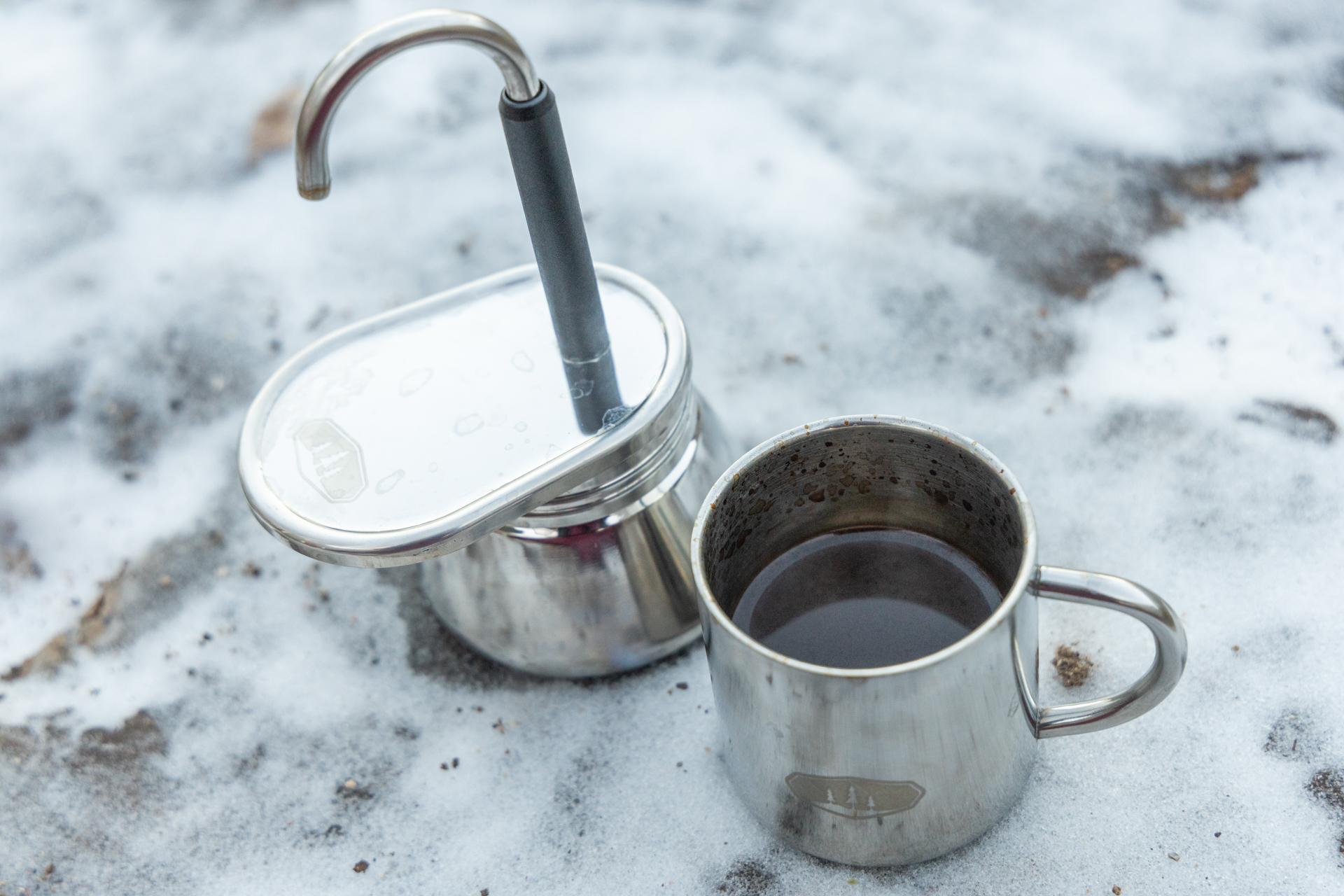
Why Trust Cleverhiker
Alisha has spent countless nights car camping, backpacking, and road tripping, always with at least one coffee-making device by her side or in her pack. Some of the coffee makers on this list she has personally used for years during weekend campouts in the Utah desert, cross-country road trips, and backpacking trips from coast to coast. She has written extensively about not only coffee makers and how to brew coffee on the trail, but also the science of coffee preparation.
Having worked for years as a barista, she hasn’t missed preparing her morning coffee for a single day in nearly 15 years. She is an unofficial camp coffee expert who is passionate about the beverage and committed to choosing the right tool for each excursion.
Analysis & Results
VALUE
If you truly love coffee and enjoy making it, even outdoors, it might be worthwhile to spend a little extra on a coffee maker you like that brews a beverage that brings you joy. However, if you’re on a budget, there are more affordable options available. Here are a few that are budget-friendly but still deliver the good stuff.
For a coffee maker that’s both affordable and offers years of use, check out the GSI Outdoors Ultralight Java Drip. It’s easy to use, allows you to customize your brew strength, and works with the coffee mug you already have. Not only is it the most affordable option on this list, but it also doesn’t require single-use filters. This means you’ll save money (and help the environment) by not having to stock up on paper filters every month or two. This makes it perhaps the best value coffee maker we tested.
The Kuju Coffee Pocket PourOver Coffee is a pleasantly affordable option, especially considering its ease of use. Simply open the package, hang the paper filter on your cup, and pour boiling water over it. Additionally, for one price, you get both a coffee maker and ground coffee, making it a two-for-one deal. However, since each device is disposable after one use, you will need to buy a new box of Kuju before every trip.
For Jetboil users, an easy add-on and an affordable investment is the Jetboil Silicone Coffee Press. For under $20, you can get a lightweight, portable accessory for your Jetboil system that transforms your pot into a French press. All you need is a mug to pour the coffee into. Since it brews several cups at a time, you won’t need to reset the system between cups for multiple people. Plus, it weighs very little and packs down to almost nothing, so you get great value for your money.
PORTABILITY
Most of the time, campers and backpackers want a coffee maker that’s easy to transport, durable, and lightweight. One that doesn’t dominate their camp kitchen box, fits easily in a backpack, and that you don’t have to worry about breaking if you toss your bag on the ground after a long day of hiking. It’s a bonus if it also nests with other necessities and gear. For those who value portability, these devices fit the bill.
The Miir Pourigami is the most portable coffee maker we tested. It disassembles and stores nearly flat thanks to its three-section design that slides together in seconds. It even includes a storage case with space for filters. It may weigh more than other coffee makers we tested, but if you don’t mind a few extra ounces, the Pourigami’s compact size and durable materials make it easy to store and transport.
For Jetboil users, the Jetboil Silicone Coffee Press is a convenient coffee-making accessory that takes up almost no room when disassembled and stored for transport. The shaft of the press comes apart with just a twist and can be removed from the filter in the same way. All three pieces stash easily in your Jetboil pot or in the base cap that came with it. This means it occupies virtually no space in your pack, allowing you to still utilize the storage functionality of your Jetboil.
Another convenient and portable option is the ESPRO Ultralight Travel Press Bottle. It’s designed to brew coffee on the go, fitting into most backpack water bottle pockets and car cup holders. Made from durable stainless steel, it is leak-proof when the lid is securely attached. You can even clip it to the outside of your pack if needed. Plus, it’s lightweight, allowing you to prepare coffee for the road or trail.
EASE OF USE
Sometimes you want to sit back and enjoy the process of making coffee. Other times, you may not have the energy to deal with complicated processes and numerous parts. If you’re looking for an easy-to-prepare brew, these options will quickly yield a quality cup. They require little to no fuss and still produce a drink you’ll want before an alpine start.
The ESPRO Ultralight Travel Press Bottle is an easy option designed for quick use. It’s a French press disguised as a travel mug, which means you can brew a mug quickly and then take it to enjoy on the trail. Just add coffee grounds to the bottom of the insulated vessel, pour in hot water, set a timer for 3-5 minutes depending on how strong you like your coffee, and then press. You don’t even have to remove the filter basket before drinking. Twist on the cap to keep it hot for hours or drink up.
Another user-friendly option is the GSI Outdoors Ultralight Java Drip. This practical pour-over device doesn’t require a paper filter. Simply clip the device onto your camp mug, add coffee to the mesh basket, pour boiling water over it, and you’ll have a piping hot mug of coffee. It’s easy to set up, user-friendly, and simple to clean and store away when you’re finished.
The Bialetti Moka Express is a classic for a reason. While some assembly is required to make a cup of espresso, we’re fine with it since this device means we don’t have to boil water separately, and the actual brew time is inactive. This allows us to eat breakfast or pack up camp while our coffee brews. Just add water to the base of the Moka Express, place coffee grounds in the basket, screw on the top, set it on the stove, and let it work its magic. You’ll be enjoying a strong cup of coffee in no time.
TIME TO BREW
Sometimes, you don’t want to sit around waiting for your coffee to be ready. We understand. If you need caffeine ASAP, check out these options. They promise to fill your mug in no time. You might never return to instant coffee again.
The fastest camp coffee maker of the bunch was the Wacaco Minipresso GR, which pumped out (literally) a shot of espresso in one minute and 20 seconds. You do have to boil water first unless you’re making cold coffee, but the actual process of adding grounds, coffee, and pumping to extract the espresso flew by during testing. Unlike the next fastest options, that brew time is active, meaning you can’t multitask while your coffee is brewing.
The Bialetti Moka Express is not only easy to use; it’s also fast. Since you don’t have to boil water first, you can prepare breakfast or pack up camp while your coffee brews. Just add water to the base of the Moka Express, add coffee grounds to the basket, screw on the top, set it on the stove, and let it do its thing. The heat creates pressure, filtering the water upward through the grounds for a strong cup of coffee that’s ready in less than two and a half minutes.
Similar in concept but with a slightly different design, the GSI Outdoors Mini Espresso maker functions much like the Bialetti. However, it brews a single small cup at a time, depositing it directly into an insulated demitasse, making it ready to drink right away. The brewing process takes less than three minutes, all of which is inactive brew time.
EASE OF CLEANUP
Cleaning up coffee grounds outdoors, especially without a sink, can be frustrating. Grounds are notoriously difficult to remove from all the nooks and crannies of coffee makers. Fortunately, these options provide quick and easy cleanup, allowing you to enjoy your coffee and get on your way.
Kuju Coffee single-use pour-over coffee pouches provide the easiest cleanup available. Since they are single-use, all you need to do after brewing your coffee is toss the used grounds and the pour-over pouch into the nearest trash can. Don’t forget to properly dispose of the packaging as well. It only takes seconds and requires as much effort as walking from your camp kitchen to a trash bag.
The Miir Pourigami is also easy to clean since it uses paper filters for coffee prepared pour-over style. After you’ve brewed your coffee, simply toss the entire filter and used grounds in the nearest trash can, then rinse off the metal device before disassembling it and placing it back in its storage case. You can use a reusable filter, of course, but be aware that this will increase cleanup time by 15-20 seconds.
The AeroPress Go also provides quick and easy clean-up, thanks to its plunger design and the use of small paper filters. After brewing, twist off the filter cap, position the entire device over a trash bag, and press down the plunger. This action expels both the coffee puck and the filter. Next, rinse the bottom of the plunger briefly to remove any stuck-on grounds, and you’re ready to go–or to reset and make another cup.
COFFEE STRENGTH
Not all coffee cups are created equal regarding potency. Some coffee-making devices produce stronger brews that are meant to energize you. Others create more mellow drinks to savor and enjoy. Personal preference will determine which you favor, but a strong cup can often be diluted while a weak cup cannot be intensified. These devices produce some of the strongest coffee among all the camp coffee makers we tested.
The Bialetti Moka Express is a powerhouse of coffee potency. In a short time, it produces a cup or two of coffee with a strength that rivals anything you’ll find at your corner coffee shop. It’s dark, rich, and easy on the palate. It’s strong enough that you can easily dilute the brew with water to create an Americano or use it as a base for a camp cappuccino.
Similarly, the GSI Outdoors Mini Espresso produces a coffee shop-quality shot of espresso. Just fill the basket with your favorite dark roast and the base with water, place it on the stove, and let it work its magic. Rich and flavorful, you can enjoy the resulting cup as it is or add water or milk to your preference without worrying about making it too weak.
Another great camp espresso maker that brews quality espresso is the Wacaco Minipresso GR. It not only produces a strong shot of coffee, but a smooth one as well. What’s more, it’s the only one that also creates crema, that light, frothy head you expect to see on any barista-prepared espresso. Additionally, you can change the coffee basket capacity from 8 grams to 12 grams by removing a plastic disc. This provides the option to craft an even more potent cup using the same amount of water but more coffee.
How to Choose a Coffee Maker for Camping and Backpacking
Every coffee drinker desires something different, not only from their morning cup, but also from the device used to make it. So consider a few factors when selecting the right coffee maker for your next camping trip.
TIME REQUIRED
Are you a wake-up-and-go type of person? Instant coffee or a device that brews coffee quickly with minimal effort on your part is likely your best bet. However, if you enjoy taking the time to create the perfect cup, you might prefer a method that is a bit more involved and allows you to customize your drink.
NUMBER OF SERVINGS
If you’re a solo camper, unless you regularly drink multiple cups at once, you may not want a device that brews 20 ounces of coffee. Instead, consider a coffee maker that prepares just one or two cups. For those who frequently travel with others, think not only about how many cups a device can brew, but also whether there’s cleanup time needed between preparing individual servings, like with a pour-over.
COFFEE TO WATER RATIO
For the best chance at the perfect cup, stick to weight-based ratios of coffee to water. The standard ratio is 16:1 water to coffee. This means you need 300 grams of water and 16 grams of coffee for one cup. A compact digital scale makes measuring easy.
CHOOSING THE RIGHT GRIND
Not all camp coffee makers require the same size of coffee grind. Espresso-style makers often need a finer grind than pour-overs, while French presses require an extra coarse grind. Consider whether you need to purchase specially ground coffee or if you should invest in a portable manual coffee grinder so you always have the right grind for the right device.
ADDITIONAL KITCHEN SUPPLIES
Will you need a kettle or pot to boil water separately from your coffee maker, or is the entire device self-contained? Do you also need a camp mug? Finally, ensure that if the device you choose requires stove-top preparation, it fits on your camp stove or backpacking stove.
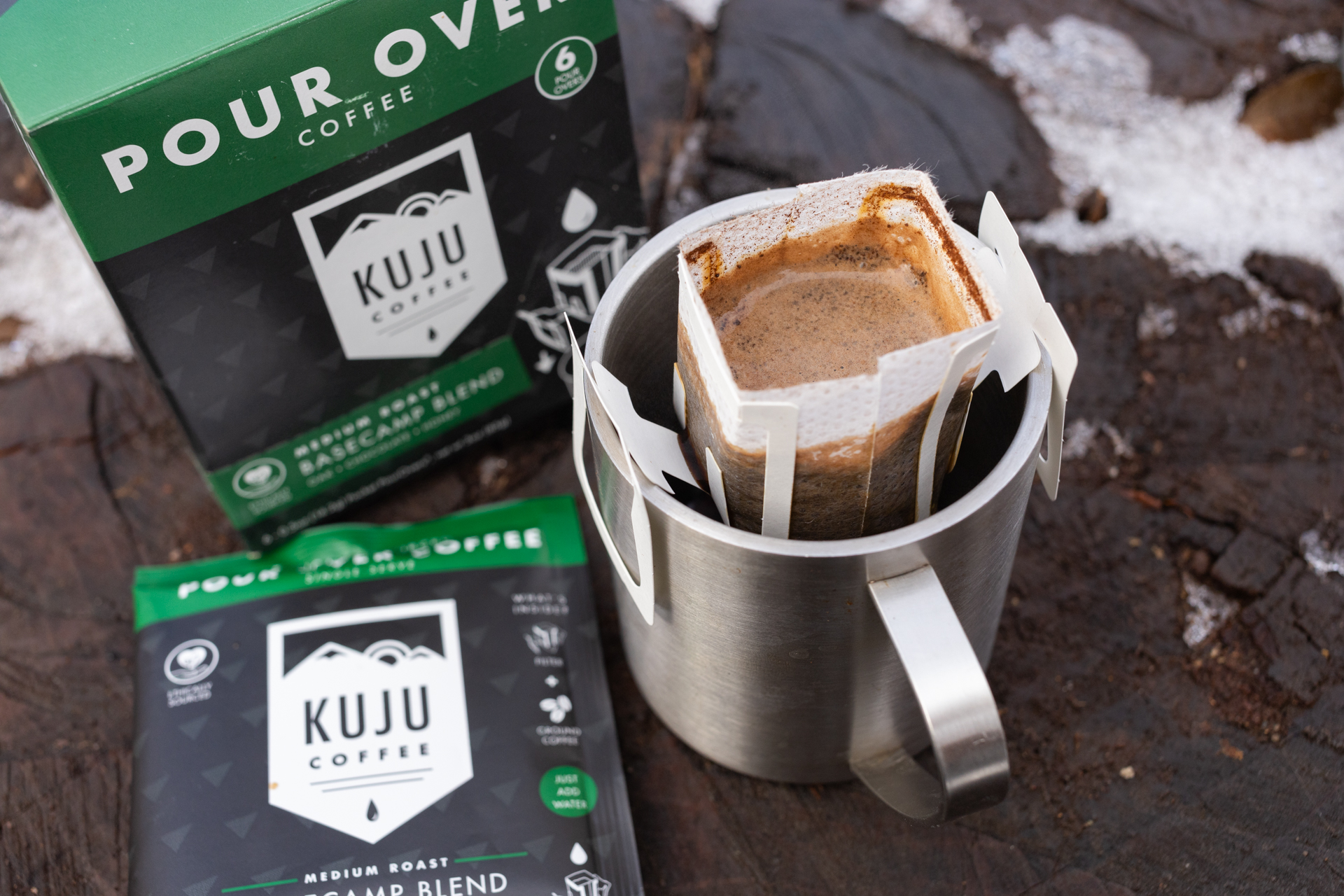
Conclusion
If you’re looking for the perfect camp coffee maker, you’ve come to the right place. We spent hours testing, researching, and sampling the brews produced by each of these devices and broke down what makes them all excellent at their jobs and how they’re unique.
Hopefully, we’ve helped you find the ideal option for your next adventure, regardless of how you enjoy your morning cup, the space you have in your bag, or your budget size. After all, just because you’re outdoors doesn’t mean you have to suffer through subpar coffee.
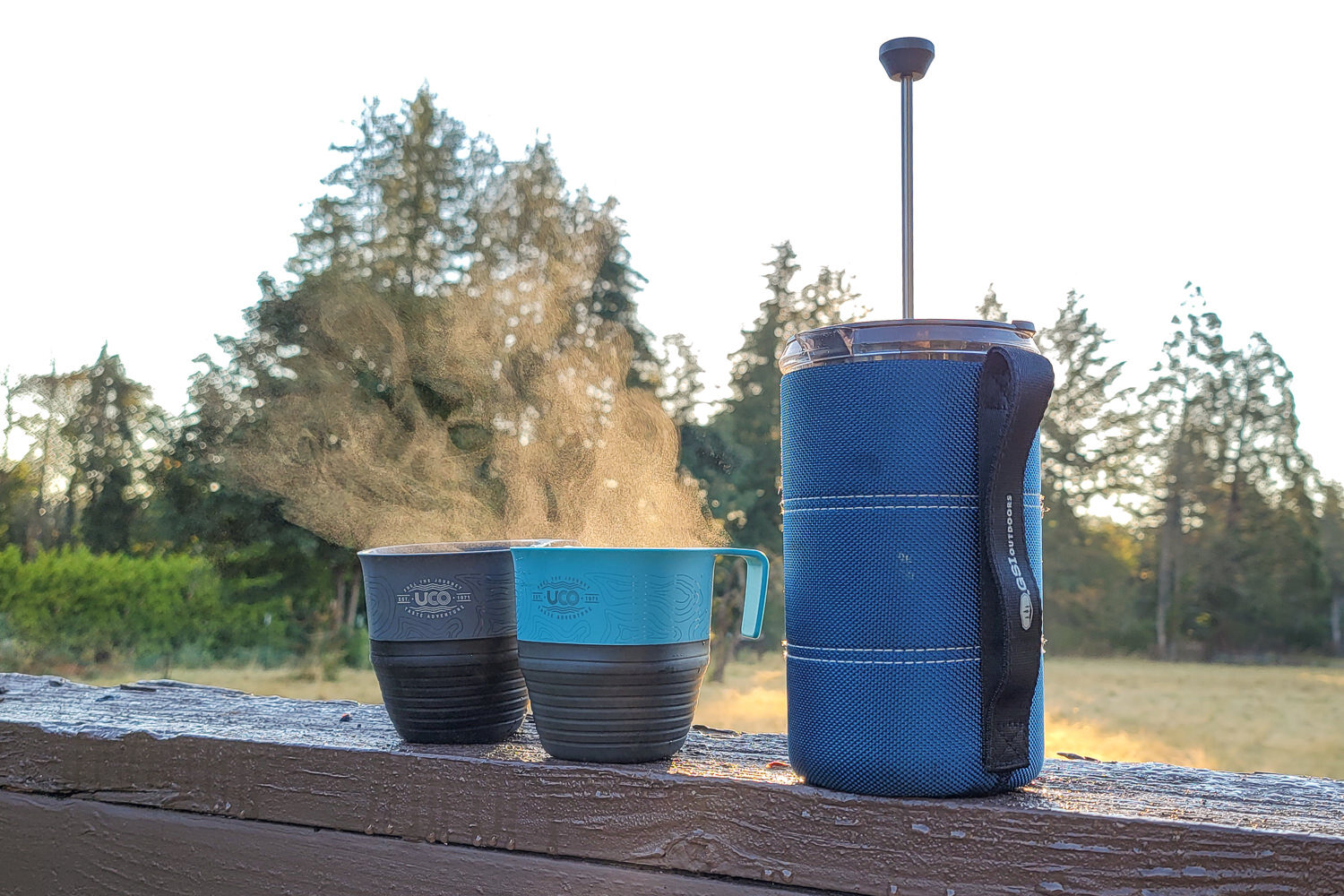
The post Best Camping & Backpacking Coffee Makers of 2025 appeared first on CleverHiker.


